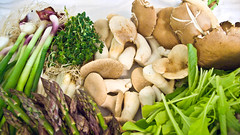Everything is getting more expensive today. From gas to groceries, our hard-earned dollars are challenged to stretch further. Now, we may be able to ride a bicycle around town if we can’t put gas in our cars. But, we have to eat -- there’s no getting around that. So, we have to find ways to spend less on groceries while still getting the things that we need to feed ourselves and our families, while staying healthy. Here are six money saving tips to try the next time you go grocery shopping.
 Image via Wikipedia
Image via Wikipedia1. Clip coupons. They put those in the newspaper for a reason. If there are new items you want to try, use a coupon to get it at a discount. If you like it, you have saved some money. On the other hand, if you don’t take a liking to it, you didn’t pay full price. Also check for online coupons, and keep an eye out for sale fliers for your local grocery store, so you can stock up on certain items when they are cheaper.
2. Buy in bulk. Consider the food items that you use most often. If they are "non-perishable" staples which keep well, you may be able to buy them in bulk usually at a lower price at food warehouses like Costco, BJ’s, and Wal-Mart. If you have a coupon, you’ll save even more money. However, as you know, we don't recommend a lot of the typical "non-perishables, as they tend not to be very healthy, so skipping the non-essentials can also help! (Do you REALLY NEED that super-size box of macaroni & cheese, or 24-pack of soda? Stop a second and think about what it's doing to your body, before you heave it into the cart....)
3. Don’t shop when you are hungry. This is a definite no-no, which I have definitely learned the hard way! Shopping on an empty stomach means that you will pick up more things than you need. You are more likely to pick up that bag of chocolate chip cookies or that box of donuts when the growling gets underway. (And you will also be more likely to buy unhealthy "convenience foods.")
4. Take a grocery list with you. This is another protection against picking up things that are too costly, or things you don't really need. Check your cabinets and the fridge to see what you need and write them down. Remember, the goal is to stick to the list as much as possible, so avoid looking around/browsing while shopping -- just go straight to the relevant sections of the store, and then get out as quickly as possible. (From a health standpoint the general rule is to keep to the outer perimeter of the store -- this is where you will find the fresher and healthier foods -- and avoid the processed foods at the center.)
5. Shop at the same stores. This is more of a frustration reliever. In a new store, you spend most of your time looking for things and walking up and down every aisle, which oftentimes leads to forgetting an item or two, as well as picking up items you happened to see, but don't really need. Going to the same store each time makes you more familiar with the prices so you can estimate your bill as you write your grocery list. You can also plan to shop at stores that carry healthier fare, so you don't get tempted by as much "bad" stuff.
6. Our favorite healthy and frugal tip - Purchase your groceries through a local
 Image by edseloh via Flickr
Image by edseloh via Flickr CSA! Buying direct from your local farmers is not only healthier and helps support your local community, but it also saves you money, and since you get most of your groceries delivered in your weekly share, it keeps you out of the grocery stores, and away from temptation -- it's a win-win-win! (For more on CSA's, and how to find one in your area, visit our website:
http://www.newholisticliving.com/csa.html)
Rising prices don’t have to mean a lean dinner table. There are ways to make your food dollar go further, while still shopping healthy, and if you take the time to implement the ideas listed above as well as others of your own, you’ll see savings each and every time you shop.
Post your own healthy and money-saving shopping tips below - we'd love to hear about them!
 Image via WikipediaThis recipe is a bit more challenging, and may be better for experienced cooks, but I love Thai food, and wanted to share. This video may make it easier to follow the recipe. (Click the link below to view the video.)
Image via WikipediaThis recipe is a bit more challenging, and may be better for experienced cooks, but I love Thai food, and wanted to share. This video may make it easier to follow the recipe. (Click the link below to view the video.)












